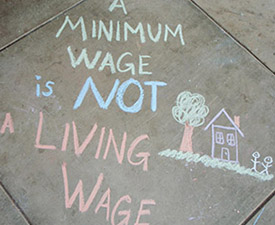The Living Wage Rate:
The 2024 Living Wage Rate for employers in Buncombe County is $22.10/hr, and the Pledged Living Wage Rate is $19/hr with a commitment to raise wages 3% plus inflation until the living wage for that year is met.
For employers in Rural WNC counties, the Living Wage Rate is $16.40/hour.
For more information about how we calculate the living wage rate and how increases are made, click here.
What are the Benefits of a Living Wage?
Today, millions of working people struggle to cover the cost of housing, food, health care, childcare and other basic necessities for themselves and their families. A worker who is paid the minimum wage of $7.25/hour, or any wage below a living wage, cannot possibly afford basic necessities without assistance. This creates problems not only for workers, but for businesses and the local economy. The living wage movement is an important initiative that can bring improve conditions for working people, businesses and our local economy.
What is a Living Wage?
A living wage is the MINIMUM amount that a worker must earn to afford their basic necessities, without public or private assistance. In short, a living wage is a more just, minimum wage.
Why isn’t Minimum Wage Enough?
The federal minimum wage was enacted through the Fair Labor Standards Act of 1938, which purpose was to eliminate “labor conditions detrimental to the maintenance of the minimum standard of living necessary for health, efficiency and general well-being of workers.” Despite these intentions, the federal minimum wage has failed to keep up with the rising cost of living, and has instead become a wage that keeps working people in poverty.
Although the dollar amount (nominal value) of minimum wage has increased over time, it now takes more dollars to purchase the same goods and services, so the real value of minimum wage has actually decreased since 1960. In 1968, the value of minimum wage was equivalent to $11.91 in 2020!
The increase of the federal minimum wage to $7.25 in 2009 was applauded by many, but because of inflation the real value of minimum wage today is still far below what it takes to the maintain “the minimum standard of living.”
People working minimum wage jobs full-time cannot afford a two-bedroom apartment in any state in the country according to the National Low Income Housing Coalition’s 2021 Out of Reach report.
Living Wages Benefit Workers:
In 2009, 35,820 workers in Buncombe County earned below a living wage and would benefit directly from living wages.
In addition, many other workers who earn slightly over a living wage will likely benefit from wage increases through the “spillover”, or “ripple”, effect. As workers with the lowest earnings in a firm are given raises, so are other workers with slightly higher wage. This “spillover” preserves the wage structure in a firm.
Living wages benefit working families. According the Economic Policy Institute, evidence from an analysis of the 1996-97 minimum wage increase shows that the average minimum wage worker brings home more than half (54%) of his or her family’s weekly earnings.
Living wages alleviate poverty among working people at the bottom of the pay scale, a demographic is which disproportionately represented by minority groups. In Buncombe County, over half of Black households (60%) and over half of Hispanic household (57%) are low-income.
A living wage reverses the trend of the declining real value of minimum wage and creates a minimum income threshold that more accurately accounts for the cost of living today.
Living Wages Benefit the Local Economy:
Living wages are part of a broad effort to end poverty and inequity, and work towards a more just and sustainable local economy.
Living wages reduce wage inequality by strengthening low-wage workers’ bargaining power in the job market.
Living wages enable working people to become self-sufficient and rely less on social services. Today, 28% of families in Buncombe County receiving food assistance work full-time. For working people to receive federal assistance is both counterintuitive and counterproductive- only a fraction of every tax dollar allocated to social services directly assists recipients of aid, while 100% of wages do.
Wage increases do not lead to job loss. A 1998 EPI study failed to find any systematic, significant job loss associated with the1996-97 minimum wage increase. In fact, the study found that following the increase, the low-wage labor market performed better than it had in decades (e.g., lower unemployment rates, increased average hourly wages, increased family income, decreased poverty rates).
Living wages stimulate the economy through increased consumer spending and the money multiplier effect.
Living Wages Benefit Businesses:
Studies have shown that paying a living wage leads to increased worker morale, worker health and quality of service. Paying a living wage also lowers absenteeism, turnover rates, and recruiting and training costs.
According to a Fiscal Policy Institute Study, states with higher minimum wages experience more small business growth, both in number of employees and in number of establishments, than states with lower minimums.
Raising wages is affordable- employers are able to absorb the costs of a wage increases through higher worker productivity and lowered administrative costs.
A recent, local survey has shown that consumers in the Asheville area are willing to pay more for living wage Certified products and services (WWC study- final analysis pending).
Just Economics has created a comprehensive benefits package for living wage Certified Employers which offers additional incentives such as discounted advertising, mutual employer discounts, marketing assistance, free invitation to networking and promotional events, and many more.
What is a Minimum Standard of Living?
The purpose of minimum wage, according to the Fair Labor Act, is to enable workers and their families to afford “the minimum standard of living necessary for health, efficiency and general well-being…” But how do we measure “the minimum standard of living”? Minimum wage income keeps workers above the federal poverty threshold, but is the federal poverty threshold a reasonable minimum standard of living?

The poverty threshold was established for statistical purposes, as a means of having something to measure against during the John F. Kennedy and Lyndon Johnson eras and the “War on Poverty”. It is calculated using a method developed in 1963, by the economist Mollie Orshansky. The federal poverty threshold is based on the cost of food and the assumption that food accounts for one-third of a person’s expenses. Using this formula, (the USDA Thrifty Food Plan multiplied by 3) the poverty threshold for one adult in 2010 is $11,161.
Although the poverty threshold is adjusted annually according to change in CPI-U, it does not account for the rising relative costs of housing, childcare, health care and transportation, which now represent a much larger portion of a family’s budget. According the Economic Policy Institute, food represents only 11% of a family’s annual budget today. The poverty threshold also does not factor in regional differences in the cost of living. The U.S. Census Bureau states that purpose of the poverty threshold is, in fact, to act“as a statistical yardstick, not as a complete description of what people and families need to live.”
For this reason, many organizations- such as Just Economics, the Economic Policy Institute, and the NC Justice Center- strive to more accurately calculate a minimum standard of living for workers and their families. The living wage movement is based on the premise that minimum wage should keep workers and their families above the minimum standard of living rather than just above the poverty threshold.
What kinds of jobs pay below a living wage?
Out of nearly 400 different occupations in Buncombe County, 59, or 15%, paid below the Living Wage Rate in 2009. Although the number of low-wage occupations is relatively low, the number of workers occupying these jobs is high. According to Employment Security Commission data released in 2009, 35,820 workers are employed in these low-wage occupations, representing nearly one third (31%) of the Buncombe County workforce.
Of Buncombe County low-wage workers, one third, 34%, are employed in food preparation and serving related occupations. 22% are retail sales workers. 10% work transportation and material moving occupations. 9% are building cleaning workers, and 9% hold office and administrative occupations. These jobs pay between $8 and $10/hour, and typically don’t offer benefits of any kind.
Many of these low-wage occupations are also among the fastest growing occupations in the Mountain Area. Of the 25 fastest growing occupations in the Mountain Area, 11 paid below a living wage in 2009. While 31% of the Buncombe County workforce earns less than a living wage today, growth in low-wage occupations will increase that ratio may be much greater by 2016.
Resources
Occupational Information, Employment and Wages by Occupation (Employment Security Commission data for Buncombe County, released 2009).
Occupational Information, Employment and Wages by Occupation (Employment Security Commission data for Buncombe County, released 2009).
These statistics represent the percent of all workers earning below $11.35/hr in Buncombe County who are employed in jobs within those occupational categories. There are also jobs within the same occupational categories (such as management level positions) that do earn a living wage.
Fastest Growing Occupations by Job Growth, Employment Outlook 2006-2016, Mountain Area WDB (Buncombe, Henderson, Madison, Transylvania Counties)North Carolina Employment Security Commission,
Pollin, Robert, Mark Brenner et al. A Measure of Fairness, p.22.
US Census Bureau, Poverty Thresholds 2009
See the EPI Family Budget Calculator, http://www.epi.org/content/budget_calculator/
http://www.census.gov/hhes/www/poverty/methods/measure.html, accessed 9/1/10
Forbes, David. “Down and Out” in the Mountain Express, May 10, 2010
Economic Policy Institute, Minimum Wage Issue Guide, p. 4.
Analysis based on Occupational Information, Employment and Wages by Occupation (Employment Security Commission data for Buncombe County, released 2009).
The Occupational Employment and Wage Statistics (OES) program collects information on employment and wages by occupation through a semi-annual survey of North Carolina industries. Just Economics used data published in 2009, which estimates of the number of workers and entry, average, and experienced wages by occupation for Buncombe County to calculate living wage statistics. All workers are full-time workers. For confidentiality purposes, data is not available for businesses that could be identified through OES (i.e. businesses of which there are only one in Buncombe County).
Economic Policy Institute, Minimum Wage Issue Guide, p. 2.
Economic Policy Institute, Minimum Wage Issue Guide, p. 3.
Source: Analysis based on U.S. Census Bureau, American Community Survey 2006-2008
Sklar, Holly.A Just Minimum Wage, p.38
A Just Minimum Wage, p.38

